The NVIDIA GeForce GTX 1080 Preview: A Look at What's to Come
by Ryan Smith on May 17, 2016 9:00 AM ESTGaming Performance, Power, Temperature, & Noise
So with the basics of the architecture and core configuration behind us, let’s dive into some numbers.
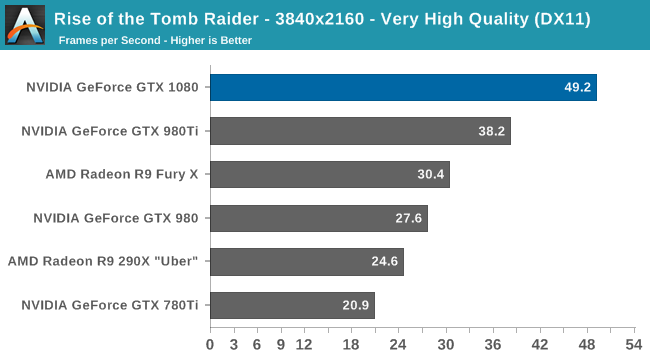

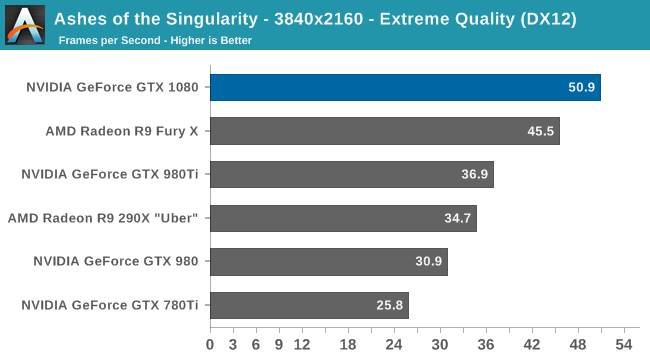

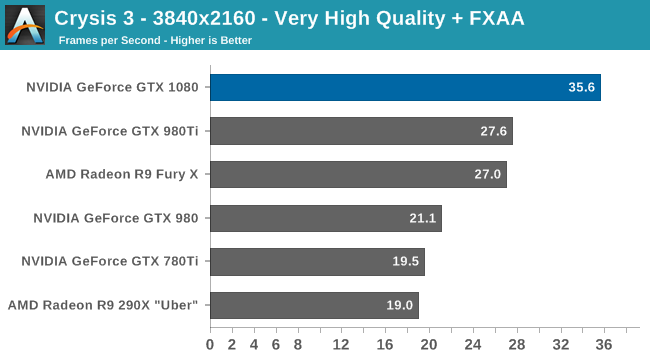
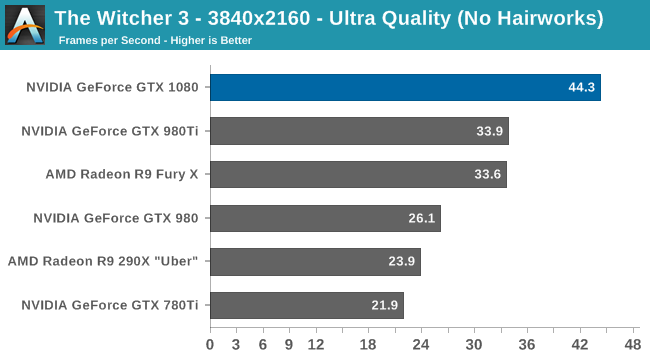
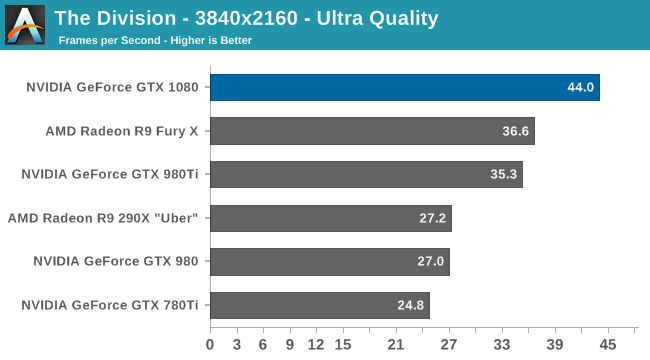
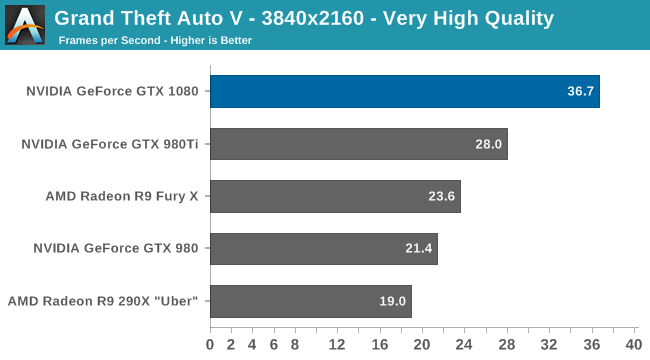
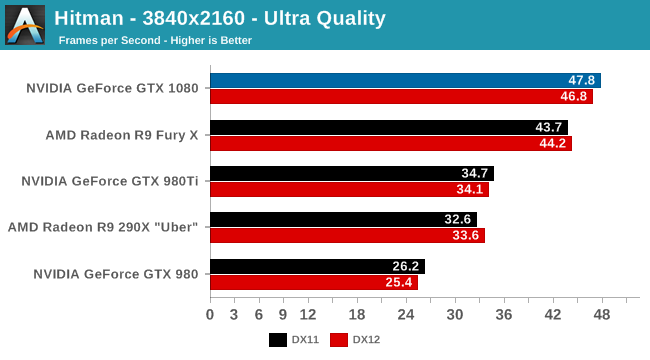
As the first high-end card of this generation to launch, NVIDIA gets to set the pace for the market. At the risk of being redundant the GTX 1080 is now the fastest single-GPU card on the market, and even at 4K it wins at every single gaming benchmark, typically by a good margin. In practice we’re looking at a 31% performance lead over GTX 980 Ti – the card the GTX 1080 essentially replaces – with a similar 32% lead over AMD’s Radeon R9 Fury X. Meanwhile against the slightly older GTX 980, that gap is 70%.
On a generational basis this ends up being very close to the 74% jump in 4K performance going from the GTX 680 to GTX 980. And although the pricing comparison is not especially flattering for NVIDIA here, it should be evident that NVIDIA isn’t just looking to sell GTX 1080 as an upgrade for high-end Kepler cards, but as an upgrade for GTX 980 as well, just 20 months after it launched.
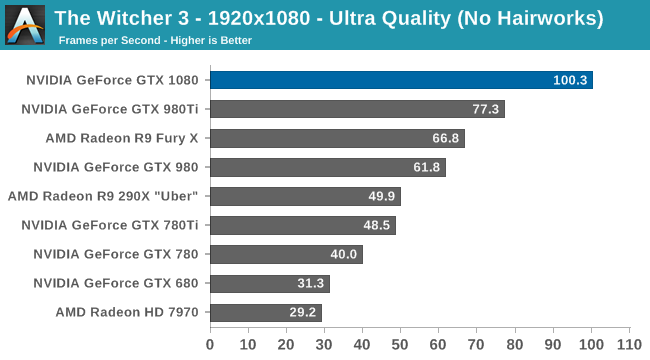
I also wanted to quickly throw in a 1080p chart, both for the interest of comparing the GTX 1080 to the first-generation 28nm cards, and for gamers who are playing on high refresh rate 1080p monitors. Though this will of course vary from game to game, roughly speaking the GTX 1080 should be 3x faster than the GTX 680 or Radeon HD 7970. This is a good reminder of how architectural efficiency has played a greater role in past years, as this is a much larger gain than we saw jumping from 55nm to 40nm or 40nm to 28nm, both of which were much closer to the historical norm of 2x.

Meanwhile when it comes to power, temperature, and noise, NVIDIA continues to execute very well here. Power consumption under Crysis 3 is some 20W higher than GTX 980 or 52W lower than GTX 980 Ti, generally in line with NVIDIA’s own TDP ratings after accounting for the slightly higher CPU power consumption incurred by the card’s higher performance. The end result is that GTX 1080 is a bit more power hungry than GTX 980, but still in the sweet spot NVIDIA has carved out in the gaming market. Broadly speaking, this amounts to a 54% increase in energy efficiency in the case of Crysis 3.
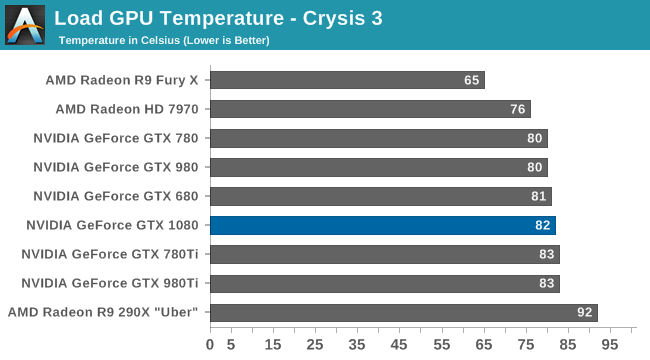
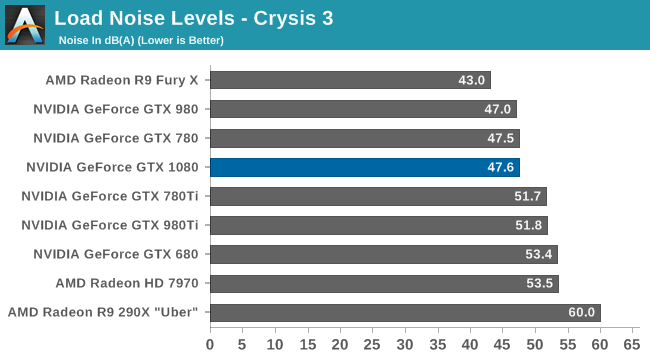
Otherwise from a design perspective the GTX 1080 Founders Edition carries on from NVIDIA’s high-end GTX 700/900 reference design, allowing NVIDIA to once again offer a superior blower-based solution. NVIDIA’s temperature management technology has not changed relative to Maxwell, so like their other cards, the GTX 1080 tops out in the low 80s for load temperature. More significantly, at 47.5 db(A) load noise, the card is on par with the GTX 780 and half a dB off of the GTX 980.
Ultimately NVIDIA has designed the GTX 1080 to be a drop-in replacement for the GTX 980, and this data confirms just that, indicating that GTX 1080’s much higher performance comes with only a slight increase in power consumption and no meaningful change in temperatures or acoustics.


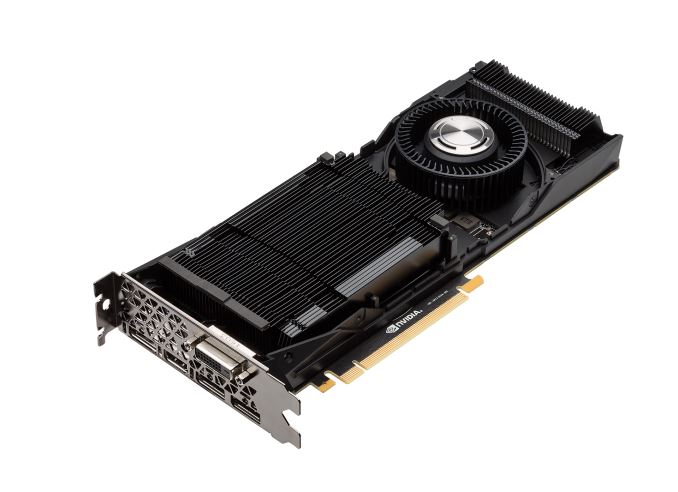








262 Comments
View All Comments
stardude82 - Sunday, June 5, 2016 - link
I'm still waiting for an GTX 950 review.TacoR0sado - Monday, June 6, 2016 - link
I guess the full article isn't coming.hafizmajid - Monday, June 6, 2016 - link
Still no review. One of the things I like about your review is. That it bring up incite that is not available else where. Do you have a timescale.HOOfan 1 - Monday, June 6, 2016 - link
Their delay seems to be inciting discontent.jwinter - Monday, June 6, 2016 - link
Coollakedude - Wednesday, June 8, 2016 - link
Speculation, for some reason they don't have card to test.Locut0s - Friday, June 10, 2016 - link
Starting to wonder if perhaps they found some crucial problems and have been spending this time trying to run them to ground. But IMHO that doesn't make the situation much better as in that case they should have updated us at some point with said fact.nsavop - Friday, June 10, 2016 - link
Why bother at this point? Using the exuse that such a in depth article takes time to write and telling everyone it's almost finished weeks ago is flat out dishonest especially considering its been happening on a consistent basis.Can't keep using the exuse that Anandtech's articles are very in depth and take longer, that might of been true years ago but not anymore, not when sites like Pcper and Techreport go just as in depth and by some miracle of God are able to get the article out on time.
The main site and the forums have been going downhill here for a while now so don't hold your breath on the "full review".
TacoR0sado - Wednesday, June 15, 2016 - link
Yeah I think it's safe to say at this point that the full review won't be happening.Beararam - Wednesday, June 15, 2016 - link
How to fade into obscurity, by the artists formerly known as Anandtech.Take over 4 weeks longer than some kid on youtube to review the fastest GPU to date, with the first die shrink in years ; don't bother at all to review the 960 or the S7 (completely); not sure what else you need to do, this is a pretty good way to sewer your company.
GTX 780 release date/review date: May 23, 2013/ May 23, 2013
GTX 980 release date/review date: Sep 18, 2014/ Sep 18, 2014
GTX 1080 release date/review date: May 27, 2016/ ???